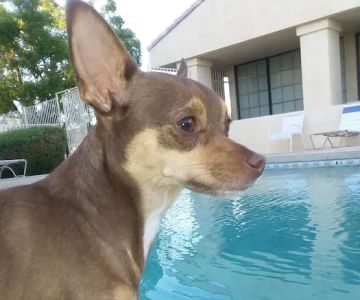How to Stop a Dog from Lunging at Other Dogs: Effective Training Tips
Having a dog that lunges at other dogs can be a stressful experience, both for you and for the other dog owners. As a dog owner, seeing your furry friend act aggressively or unpredictably when encountering other dogs can be concerning. But the good news is that with proper training and understanding, you can address this behavior and help your dog become more relaxed and well-mannered around other dogs. In this article, I’ll share my personal experiences and some effective strategies to stop a dog from lunging at other dogs.
1. Understanding Why Dogs Lunge at Other Dogs
Before you can effectively stop your dog from lunging, it’s important to understand why this behavior happens. Lunging is typically a sign of frustration, fear, or excitement, and in some cases, it’s linked to territorial behavior. When a dog lunges, it could be reacting to something that triggers its anxiety or aggression. This could be other dogs, unfamiliar scents, or a lack of proper socialization with other animals.
In some cases, dogs that haven’t been properly socialized or those that have had negative experiences with other dogs may lunge to defend themselves. On the other hand, some dogs lunge out of sheer excitement, wanting to play with the other dog. Understanding the root cause of your dog’s lunging is key to addressing the behavior effectively.
2. Using Positive Reinforcement to Train Your Dog
One of the most effective ways to prevent lunging is through positive reinforcement. This involves rewarding your dog for good behavior, which helps them associate calmness with positive outcomes. When your dog remains calm and doesn’t lunge, reward them with treats, praise, or a toy. This teaches your dog that staying relaxed in the presence of other dogs leads to something good, reinforcing the behavior you want to see more of.
When you’re out on walks, if your dog starts to lunge, immediately redirect their attention by using a command like "look" or "watch me." When they look at you, offer praise and a treat. This helps them focus on you instead of the other dog, making it less likely that they will act aggressively or excitedly.
3. Proper Leash Training
Leash training is a critical part of stopping your dog from lunging. If your dog is on a leash when they encounter other dogs, they may feel restrained and frustrated, which can lead to lunging. The first step in leash training is to make sure that your dog has a loose leash at all times. Tension on the leash can signal to your dog that something is wrong or that they need to react to the situation.
To practice loose-leash walking, use positive reinforcement when your dog walks beside you without pulling. If your dog starts lunging or pulling, stop walking and wait for them to calm down. Once they stop pulling, start walking again. This reinforces the idea that pulling or lunging gets them nowhere, while walking calmly beside you will keep things moving.
4. Gradual Exposure to Other Dogs
If your dog is fearful of other dogs, a great way to prevent lunging is through gradual exposure. This means slowly introducing your dog to other dogs in a controlled environment. Start by observing other dogs from a distance, gradually decreasing the distance between your dog and the other dogs over time as they become more comfortable.
During these sessions, ensure that your dog is on a leash, and keep them calm by rewarding them for staying relaxed. If your dog becomes anxious or starts lunging, increase the distance between them and the other dog and give them a moment to calm down. This process of desensitization helps your dog become more accustomed to being around other dogs without reacting aggressively.
5. Hiring a Professional Dog Trainer
If you’ve tried the methods above and still struggle with your dog’s lunging behavior, it may be time to consult a professional dog trainer. A trainer can assess your dog’s behavior, identify triggers for the lunging, and create a tailored plan to address the issue. Professional trainers use proven methods, such as clicker training, behavioral modification, and desensitization techniques to help dogs learn appropriate social behaviors.
Working with a professional trainer can also provide valuable insights into your dog’s behavior that you might not have noticed on your own. Additionally, they can work with you to teach consistent commands and reinforce the right behaviors, helping your dog learn proper manners around other dogs.
6. Providing Enough Mental and Physical Stimulation
Dogs that don’t get enough exercise or mental stimulation are more likely to engage in undesirable behaviors like lunging. If your dog has excess energy or is not mentally challenged, they may become reactive when they encounter other dogs. Regular physical exercise, such as walks, runs, or playtime, is essential to keeping your dog calm and well-behaved.
Additionally, providing your dog with puzzle toys, training sessions, and other forms of mental enrichment can help reduce stress and anxiety, which often lead to lunging. A tired and mentally stimulated dog is less likely to act out in reactive ways, making your walks and outings much more enjoyable.
Conclusion: Patience and Consistency are Key
In conclusion, stopping a dog from lunging at other dogs takes time, patience, and consistency. It’s important to understand the root cause of your dog’s behavior, whether it’s fear, frustration, or excitement, and address it through positive reinforcement, proper leash training, and gradual exposure. With the right approach, you can help your dog become more calm and composed during walks and social interactions.
Remember, each dog is unique, and it may take time for them to overcome lunging behavior. If you’re unsure of how to proceed or need additional help, don’t hesitate to consult a professional dog trainer. With dedication and the right techniques, your dog can learn to interact calmly with other dogs, making walks more enjoyable for everyone involved.











